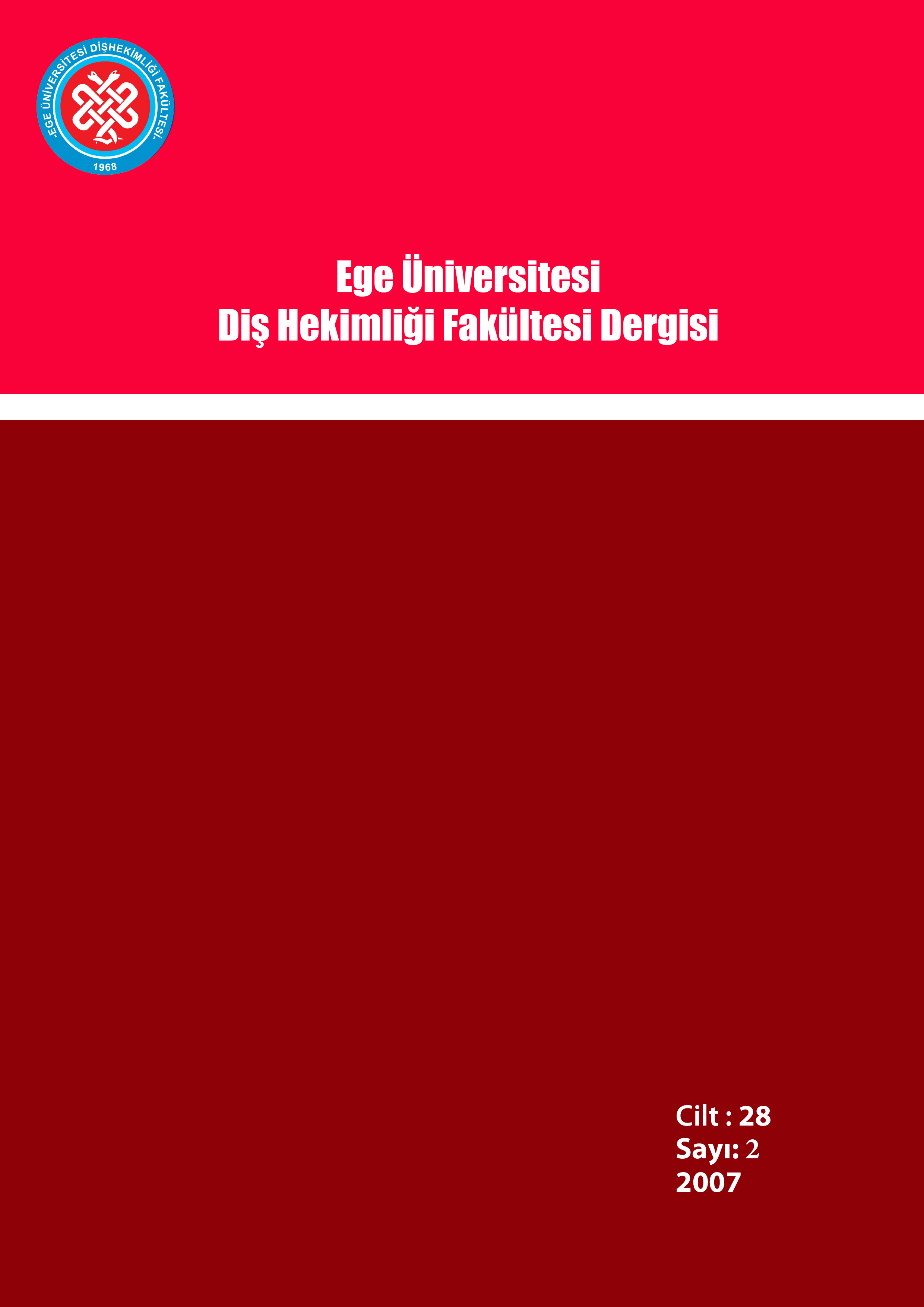
Bu eser Creative Commons Alıntı-GayriTicari-Türetilemez 4.0 Uluslararası Lisansı ile lisanslanmıştır.


An Evaluation of the Causes and the Methods of Removal of Fixed Partial Dentures
Niler Özdemir1, Gülcan Coşkun Akar2, Hatice Uluer3, Gökhan Aksoy11Ege University, School of Dentistry, Department of Prosthetic Dentistry2Ege University, Atatürk Graduate School of Medical Services
3Ege University, School of Medicine, Department of Biostatistics And Medical Informatics
OBJECTIVE: The aim of this study was to evaluate the fixed partial dentures (FPDs) from an aspect of the mean survival time of restorations, location where they were prepared, type of restorative material, crown removal technique and removal indication.
METHODS: This study was carried on 115 patients (85 women and 30 men) who had 15 (13%) full metal crown restorations, 63 (54.8%) metal-acrylic and 37 (32.2%) metal-ceramic bridgeworks, those survival time ranged between 35 and 76 (mean 53.98±8.55). In addition to the demographic data of the patients, the number of units, (pontics, abutments and cantilever) location of restoration in the arch, age and type of the restorations, type of restorative material, reasons for removal and departments that
requested the removal of FPDs were also recorded. Multiple comparisons were analyzed with Mann-Whitney U, Chi Square and Kruskal-Wallis H tests (α=0.05).
RESULTS: 100 bridges of 727 units containing 464 abutments (mean 4.64±2.02), range 1-9) and 263 pontics (mean 2.63±1.23, range 1-9) were evaluated in this study. The number of unit distribution on the type of restorative material was, 290 abutments (2.66 (±1.16), 2-9) and 168 pontics (1.92 (±1.29), 1-9) for 63 metal-acrylic restorations, 174 abutments (2.56 (±1.36), 1-7) and 95 pontics (2.08 (±1.21), 1-7) for 37 metal-ceramic restorations respectively. Age of crown and bridge restorations ranged from 1 to 39 years and the mean age was calculated as 8.95±7.47 years. Reasons for removal of restorations were arranged as toothache (%37.4), periodontal problems (%20), replacement (%15.6) and lack of retention (%12.2). Multiple comparisons between the type of restorative material, departments that requested the removal of restorations, reasons and techniques of removal were not found to be statistically significant (p>0.05). The relations between the mean age of restorations and departments requested the removal (p=0.04), reasons for removal (p=0.00), and removal technique (p=0.02) were found to be significant.
CONCLUSION: Toothache was determined to be the main reason for the removal of restorations. Restoration removal technique changes depending on the number of units and the mean age of restorations.
Sabit Protetik Restorasyonların Söküm Nedenleri ve Yöntemlerinin Değerlendirilmesi
Niler Özdemir1, Gülcan Coşkun Akar2, Hatice Uluer3, Gökhan Aksoy11Ege Üniversitesi, Dişhekimliği Fakültesi, Protetik Diş Tedavisi Anabilim Dalı2Ege Üniversitesi, Atatürk Sağlık Hizmetleri Meslek Yüksekokulu
3Ege Üniversitesi, Tıp Fakültesi, Biyoistatistik ve Tıbbi Bilişim Anabilim Dalı
AMAÇ: Bu çalışmada, sabit protetik restorasyonların yapıldığı yer (özel muayenehane, devlet hastanesi, üniversite vb.), restorasyon için kullanılan materyal, kullanım süresi, söküm endikasyonu ve kullanılan söküm tekniği açısından değerlendirilmesi amaçlandı.
YÖNTEMLER: Çalışma, 15’i (%13) tüm metal kron, 63’ü (%54,8) metal-akrilik ve 37’si (%32,2) metal-seramik köprü protezi taşıyan, yaşları 35-76 arasında değişen (53,98±8,55) 115 kişi (85 kadın; 30 erkek) üzerinde yürütüldü. Demografik veriler ile birlikte, söküm endikasyonu konulan sabit protetik restorasyonların çeşidi, üye sayısı (destek, gövde, kanat), yapıldığı malzeme, restorasyonun yaşı, yapıldığı yer, sökümü isteyen bölüm, söküm nedeni ve söküm yöntemi hazırlanan formlara kaydedildi. İkili karşılaştırmalar için Mann-Whitney U, Ki Kare, diğer karşılaştırmalar için Kruskal-Wallis H testlerinden yararlanıldı (α=0,05).
BULGULAR: Çalışmada 464’ü destek (4,64±2,02), 1-9), 263’ü gövde (2,63±1,23), 1-9) olmak üzere toplam 727 üyeye sahip 100 köprü protezi değerlendirildi. Köprü protezlerinin restorasyon cinsine göre üye sayıları, 63 metal-akrilik restorasyon için, 290 destek (2,66
(±1,16), 2-9), 168 gövde (1,92 (±1.29), 1-9), 37 metal-seramik restorasyon için ise, 174 destek (2,56 (±1,36), 1-7), 95 gövde (2,08 (±1,21), 1-7) olarak sıralanmaktadır. Köprü ve kron restorasyonları için kullanım süresi 1-39 yıl arasında değişmekle birlikte
ortalama kullanım süresi 8,95±7,47 yıldı. Restorasyonların söküm nedenleri, destek dişte ağrı (%37,4), periodontal sorun (%20), yenileme (%15,6) ve restorasyonda retansiyon kaybı (%12,2) olarak sıralanmaktadır. Sabit protetik restorasyon materyalleri ile
çıkarılmasını isteyen bölüm, çıkarılma nedeni ve çıkarılma yöntemi arasındaki ilişkiler anlamsızdır (p>0,05). Restorasyonun ortalama kullanım süresi ile söküm isteyen bölüm (p=0,04), söküm nedeni (p=0,00) ve söküm yöntemi (p=0.02) arasındaki ilişkiler anlamlıdır.
SONUÇ: Tüm restorasyonların sökümlerinde ilk neden destek dişte ağrıdır. Restorasyonun ortalama kullanım süresi ve üye sayısına göre uygulanan söküm yöntemi değişmektedir.
Manuscript Language: Turkish


